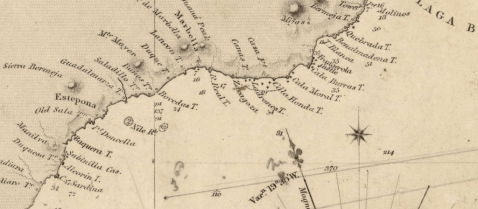Torre de Calaburras watchtower, Mijas Costa
This tower is also known as Calburra or simply Burras. A document dated 1571 mentions La Cala and the station of Burras (a small military base) but it was not until 1574 when Francisco de Cordoba, Capitan General of the Kingdom of Granada gave 75.000 maravidis for the building of the tower which was completed the following year, although at a cost of 200,000 maravedís (550 ducados). The next surviving reference is in 1634 when Pedro de Texeira included Torre de Calaburras and Torre de Calahonda in his book ‘Description of Spain and the coasts and ports of its Kingdoms’.
In 1762 a report indicated that Torre de Calaburras was in average condition with a four pound cannon. The general plans of 1767 mentions that the tower needs to be reinforced and repaired. The works were carried out and two four pound cannons were installed. Further report up to 1821 indicate again that the tower was in need of repair. In 1830 the tower was manned by a corporal, four soldier and three tower keepers.
Later in 1857 it was described as the ‘new watchtower’ 120 yards form the sea crowning a hill and a base perimeter of 21 varas (old measure just under a metre) and conical in shape. On the roof was a small ‘garita’ (guard post) and the tower entrance was at 6.5m above the ground and facing the sea.
In 1863 the first lighthouse for shipping was built nearby, it was rebuilt in 1928 as a 23m tall tower.
The Torre de Calaburas was declared 'Bien de Interes cultural' (listed building) in 1985.
Coastal Watchtowers
There have been about 200 watchtowers or forts build along the coast of Southern Spain. All with the purpose of looking out for invaders from the South. Some of the watchtowers seen today are Moorish origins, mainly constructed by the Nasrid dynasty of Granada after 1250. Most of the present wachtowers were constructed around 1575
Over half the towers constructed have lasted to the present day; both due to their remarkable solid construction and due to being in use up to the middle of the 20th century. There are about 10 different architectural constructions. The towers that are Moorish are identified from being cylindrical or rectangular in shape with vertical walls, whereas the majority were constructed (or reconstructed) in the major coastal defence programme of King Filipe II in 1575 are slightly conical in shape.
After 1518 attacks by Barbary pirates, (also known as Barbary corsairs, or Ottoman corsairs) based in North Africa and acting on behalf of the Ottoman Sultan. Initially the pirate raids concentrated on shipping but escalating to land raids. They were slave-hunters, and their methods were ferocious, capturing young people for the Ottoman slave trade.
Read the full account of the Coastal watchtowers.
Watchtowers of Mijas Costa
In Mijas Coast one can find three watch towers and one fort. From west to east:
Torre de Calahonda
Torre de Calahoda is located over looking Playa Calahonda in the grounds of a private villa. It was constructed in 1575. More >
Torre Nueva
Torre Nueva de la Cala del Moral, also called Penta Pesetos, located in the grounds of an housing estate on the headland west of La Cala de Mijas. It was constructed in 1,568. More >
Torre Batería de la Cala del Moral
This is the fort in the centre of La Cala de Mijas. It has been reformed and can be explored and the views from the roof can be viewsd. It contains a 'centro de interpretation' (visitors centre) which explains the history of the towers in Mijas Costa. It was constructed about between 1766 and 1773. More >
Torre de Calaburras
Torre de Calaburras is located on the headland within El Faro housing estate above the modern lighthouse. It was constructed in 1,1574. More >
Location
Calle Granada, Urb El Faro, Mijas Costa.
